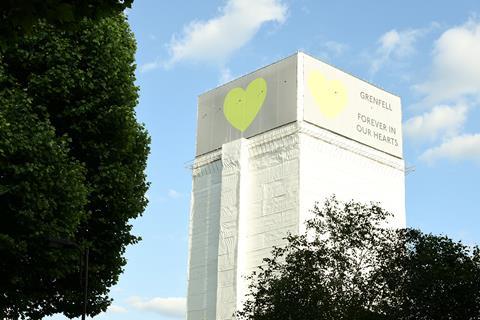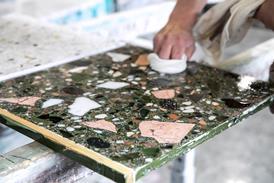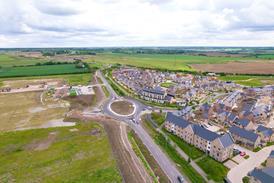Adrian Attwood exposes the crisis in heritage-conservation craft skills, and makes a plea for more young people to be encouraged into the field

From the Elizabeth Tower to Westminster Abbey, and Hampton Court Palace to Blenheim Palace; in a career of more than 30 years, I have worked on some of Britain’s most iconic buildings and seen first hand the remarkable skill that goes into preserving our built heritage. But today I am concerned about a crisis that threatens the very future of this work – we are running out of skilled craftspeople.
This isn’t hyperbole. The heritage-conservation sector faces a critical skills shortage, and the clock is ticking. We have an ageing workforce, a significant generational gap and insufficient numbers of young people entering these vocational careers. Without taking action, we risk losing vital skills – and even potentially losing centuries of accumulated knowledge and expertise.
The scale of the challenge
When DBR undertook the conservation of the Elizabeth Tower (better known as Big Ben), we initially estimated we would need to replace 250-300 stones. After detailed inspection, that number grew to over 1000 individual interventions. Each stone required thorough assessment, careful removal, precise carving and precise placement, using traditional fixing techniques with lime mortar bedding and stainless-steel dowels.
This intense level of work demands craftspeople who understand both historical methods and modern conservation principles. A skilled stonemason takes up to five years to become accomplished and ten years to reach master craftsman level. Currently, DBR has 15 stonemasons on our books. To put that in context, a single complex stone for a church arch can take seven days to complete. The mathematics are sobering.
Why aren’t young people choosing heritage crafts?
Young people simply aren’t being taught about the potential of vocational careers in schools. Education systems overwhelmingly stress academic routes over acquiring practical skills, creating a cultural bias that overlooks expert craftsmanship. The message sent to students is that success means university, not a workshop.
Yet careers in heritage crafts offer genuine fulfilment, excellent earning potential and the opportunity to work on the buildings that define Britain’s cultural identity. Where else can you say your work will be appreciated for centuries? Our craftspeople have helped restore structures that have stood for over 1000 years. A legacy few professions can match.
![thumbnail_IMG_0643[52].jpg](https://d3sux4fmh2nu8u.cloudfront.net/Pictures/480xAny/9/1/2/2017912_thumbnail_img_064352.jpg_393375.jpeg)
Our response: the education and skills centre
We refuse to wait around for others to solve this problem. That is why we have established the DBR heritage education and skills centre in West Sussex; a dual-purpose facility functioning both as a training space and a working historic-building conservation facility.
The centre offers workshops in stonemasonry, joinery and lead working, alongside a lecture theatre for educational sessions. It is designed to give young people hands-on experience with the materials and techniques they will use throughout their careers. It also shows them what these careers actually look like.
We want to educate the next generation of craftspeople into heritage and conservation. This means going beyond technical training to instil an understanding of why this work is important. When you are repointing medieval walls at Westminster Abbey with lime mortar, you are not just following a job spec, you are participating in a tradition of care that stretches back centuries.
What architects and specifiers need to know
For the architects, specifiers and planning professionals reading this, the skills shortage has direct implications for your projects. Heritage conservation is not just about aesthetics or compliance, it is also about finding craftspeople with the vocation and talent needed to execute work to the standards these buildings deserve.
For example, at Olympia London, we are currently restoring allegorical figures to the entrance, replacing sculptures that were removed in the mid-20th century. This project involves extensive archival research, collaboration with acclaimed stone carver Simon Smith, working with detailed drawings and clay maquettes, and sourcing Portland stone blocks from specialist quarries. The work demands a range of skills and a scholarly understanding of historical context and construction methods.
This is the reality of heritage conservation in 2025. Projects involve teams who can interpret limited historical records, select appropriate materials, apply traditional techniques and ensure structural integrity, all while working within live build environments. For example, at the Natural History Museum, an innovative rolling scaffolding system allowed us to execute comprehensive retrofitting roof works, while the museum remained open to the public. It is conservation without the dreaded ”Closed for renovation” signs.
A call to action
Britain’s built heritage is irreplaceable. Every time we lose a skilled craftsperson without training their successor, we diminish our capacity to care for the buildings that define our cultural landscape. The solution requires collective effort.
Schools must present vocational careers as viable, valuable pathways. Industry needs to invest in training facilities and apprenticeships. Government should support initiatives that preserve traditional skills while recognising their modern economic value.
We are playing our part through our heritage education and skills centre, our partnership with the Queen Elizabeth Scholarship Trust and our commitment to recruiting passionate craftspeople. We are also a founding member of the Historic Environment Skills Forum.
We need young people to see careers in heritage crafts as genuine opportunities – and we need parents and educators to understand that working with your hands doesn’t limit potential, it means building something that lasts.
The future of Britain’s heritage
When you stand before Westminster Abbey or the Elizabeth Tower, you are witnessing the cumulative work of generations of craftspeople. Their skills have ensured the survival of these world-famous buildings. Our challenge is to ensure the same for future generations. Along with historical significance comes the ongoing responsibility for its preservation.
The heritage skills crisis is becoming urgent. But it is not insurmountable: with commitment, investment and a fundamental shift in how we value vocational careers, we can train the craftspeople that Britain’s built heritage requires. The past has given us extraordinary buildings. Now, we must do all we can to give them a future.
Postscript
Adrian Attwood ACR is executive director and chairman at DBR



























No comments yet